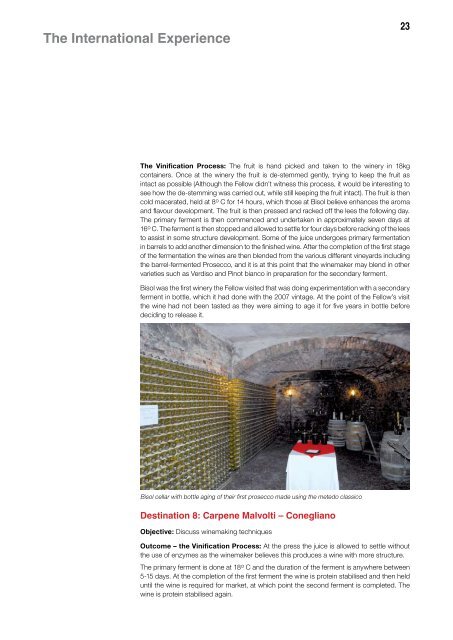Prosecco: a Grape Variety From the Veneto Region - International ...
Prosecco: a Grape Variety From the Veneto Region - International ...
Prosecco: a Grape Variety From the Veneto Region - International ...
You also want an ePaper? Increase the reach of your titles
YUMPU automatically turns print PDFs into web optimized ePapers that Google loves.
The <strong>International</strong> Experience<br />
The Vinification Process: The fruit is hand picked and taken to <strong>the</strong> winery in 18kg<br />
containers. Once at <strong>the</strong> winery <strong>the</strong> fruit is de-stemmed gently, trying to keep <strong>the</strong> fruit as<br />
intact as possible (Although <strong>the</strong> Fellow didn’t witness this process, it would be interesting to<br />
see how <strong>the</strong> de-stemming was carried out, while still keeping <strong>the</strong> fruit intact). The fruit is <strong>the</strong>n<br />
cold macerated, held at 8 o C for 14 hours, which those at Bisol believe enhances <strong>the</strong> aroma<br />
and flavour development. The fruit is <strong>the</strong>n pressed and racked off <strong>the</strong> lees <strong>the</strong> following day.<br />
The primary ferment is <strong>the</strong>n commenced and undertaken in approximately seven days at<br />
16 o C. The ferment is <strong>the</strong>n stopped and allowed to settle for four days before racking of <strong>the</strong> lees<br />
to assist in some structure development. Some of <strong>the</strong> juice undergoes primary fermentation<br />
in barrels to add ano<strong>the</strong>r dimension to <strong>the</strong> finished wine. After <strong>the</strong> completion of <strong>the</strong> first stage<br />
of <strong>the</strong> fermentation <strong>the</strong> wines are <strong>the</strong>n blended from <strong>the</strong> various different vineyards including<br />
<strong>the</strong> barrel-fermented <strong>Prosecco</strong>, and it is at this point that <strong>the</strong> winemaker may blend in o<strong>the</strong>r<br />
varieties such as Verdiso and Pinot bianco in preparation for <strong>the</strong> secondary ferment.<br />
Bisol was <strong>the</strong> first winery <strong>the</strong> Fellow visited that was doing experimentation with a secondary<br />
ferment in bottle, which it had done with <strong>the</strong> 2007 vintage. At <strong>the</strong> point of <strong>the</strong> Fellow’s visit<br />
<strong>the</strong> wine had not been tasted as <strong>the</strong>y were aiming to age it for five years in bottle before<br />
deciding to release it.<br />
Bisol cellar with bottle aging of <strong>the</strong>ir first prosecco made using <strong>the</strong> metedo classico<br />
Destination 8: Carpene Malvolti – Conegliano<br />
Objective: Discuss winemaking techniques<br />
Outcome – <strong>the</strong> Vinification Process: At <strong>the</strong> press <strong>the</strong> juice is allowed to settle without<br />
<strong>the</strong> use of enzymes as <strong>the</strong> winemaker believes this produces a wine with more structure.<br />
The primary ferment is done at 18 o C and <strong>the</strong> duration of <strong>the</strong> ferment is anywhere between<br />
5-15 days. At <strong>the</strong> completion of <strong>the</strong> first ferment <strong>the</strong> wine is protein stabilised and <strong>the</strong>n held<br />
until <strong>the</strong> wine is required for market, at which point <strong>the</strong> second ferment is completed. The<br />
wine is protein stabilised again.<br />
23

















